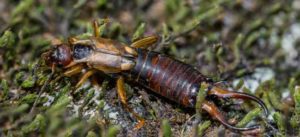IS YOUR BASEMENT A LITTLE TOO BUGGY?
By Zachary Ciras on June 3, 2020.
Our house has a basement with window wells and a below ground entrance door. No matter how we try to seal openings, etc., we get bugs inside – millipedes, earwigs, sowbugs, to name a few. What can we do to stop this migration?
L. B., Windham, NH
Insects and other arthropods do very well in basements, especially basements that are unfinished or only partially finished and are well below grade (see Here’s Why Pests Love Your Basement!).
These pests enter basements usually for three main reasons:
1. — to escape detrimental outside conditions such as cold, dryness, or temporary flooding.
2. — because they crave and require the higher humidity found in a basement. Once inside a structure, these foundation pests normally dry out too much in indoor air and die, but the extra dampness in a basement allows them to survive, and maybe even reproduce.
3. — and, because they can. Openings around doors, windows, vents, and foundation cracks let pests inside.
THINGS YOU CAN DO
Check the humidity level in your basement, if you can, to see just how damp it is. Then take steps to reduce that extra moisture and condensation by increasing ventilation and drying out the space with dehumidifiers and fans. If there is a sump pump, make sure it is functioning properly. Some pests, such as fungus beetles and springtails, are in basements just to feed on the mildew growing on damp surfaces (see Moisture Problems Cause Pest Problems).
Make sure windows and vents are screened and that gaps around electrical, cable, and pipe conduits entering through walls are caulked. The basement door should have a threshold and weatherproofing strips to seal door sides and top. Check the exterior foundation for standing water, nonfunctioning downspouts, dripping spigots, anything that means too much moisture near exterior walls, windows, or doors. The below grade window and door wells need special attention since they are ideally situated to collect and hold irrigation or rainwater, wet debris, and pests. Make sure any drains are clear of debris.
TAKE CONTROL ON THE OUTSIDE

Earwig, Shutterstock. A common pest in damp environments, like basements.
One of the best ways to keep these various foundation pests (crickets, earwigs, ground beetles, millipedes, pillbugs, cockroaches, centipedes, spiders) from ending up in your basement is to control them on the outside where they live, before they ever make that move. That can be done with chemical treatments and by changing the conditions (food, moisture, and shelter) that attract pests to your foundation in the first place.
Too much mulch that stays constantly wet is probably the number one attractant. Switch to nonorganic mulch or stone, or remove most of the wood mulch leaving just a thin layer than can dry out. Remove decaying leaves, grass clippings, weeds, and heavy groundcover plants from the foundation. Relocate stacks of firewood, building materials, stones, etc. away from the foundation.
THINGS COLONIAL CAN DO FOR YOU
Controlling pests on the outside to prevent problems on the inside is why we offer a semi-annual Preventative Maintenance Program that treats the exterior foundation of your home twice a year, timed to coincide with pest migrations. Work is done on the outside, so you don’t even have to be home. Our technician will also treat around your basement door, window wells, and any other potential basement entry points. We also offer pest-proofing services to screen, caulk, and seal up exterior pest openings.
If your basement is not part of your regular living space and is infrequently occupied, it could be a good site for a Zero Contact treatment on the inside as well. If deemed necessary, our technician will treat corners, baseboards, around doorways and window frames, anyplace that pests can enter or hide in your basement.
All of our work is done utilizing coronavirus safety precautions and our Zero Contact services including electronic appointment notification, and fully electronic billing (see our COVID-19 page for details).
For more information on controlling basement pests, see: